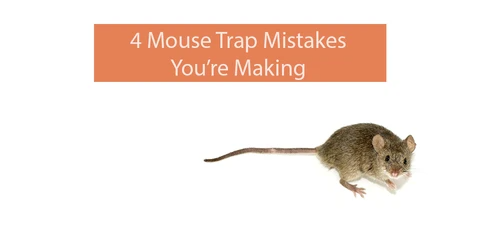
4 Mouse Trap Mistakes You're Making

When you find yourself in the middle of a rodent problem, the situation can get frustrating—fast. It seems like a rat or mouse infestation should have a simple solution. After all, humans and rodents have been battling it out for a long time. Why are your rodent problems persisting?
If you’re struggling with rats or mice in your home, the problem may boil down to the way you’re using mouse traps. But don’t worry, it’s not your fault. Although snap and glue traps have been around for decades, they’re not always very effective.
Here are the top four mouse trap mistakes you might be making:
1. Not using enough traps.
Many homeowners think that putting out a few snap or glue traps will eventually solve any rodent problem. But unless you’re dealing with just a single rat or mouse that’s confined to a small area, that’s not going to cut it.
Experts recommend that homeowners put out up to three snap or glue traps for every rodent present. That means if you have 10 mice scurrying around your attic, you’ll need to use up to 30 snap or glue traps for them to be truly effective. In reality, most homeowners are using nowhere near that number, and so their rodent problems persist.
2. Putting the traps in the wrong place.
Rodents are cautious animals, and they like to move from place to place by sticking close to walls, fences, bushes, and other sources of cover. If you’re having trouble catching mice or rats using snap or glue traps, you might take a second look at where you’re placing them. If traps are in the wrong place, rodents will easily sidestep them. Ideally, the traps should be placed about 2 to 10 feet apart in the area the rodents are most active.
If the infestation is in your attic, place traps along the walls and in corners. If it is in the livable areas of your home, traps should go in cabinets, behind appliances, and in corners.
3. Using the wrong bait.
Many homeowners assume a snap trap baited with cheese is a no-fail solution to any rodent problem. Unfortunately, this approach is a lot less effective than what we’ve been led to believe. Did you know some types of rats don’t even eat cheese? Certain rodents, such as common roof rats, won’t touch the stuff. To make matters worse, some rats are extremely adept at stealing bait without setting off a snap trap, rendering your traps useless.
4. Not checking the traps often enough.
One of the biggest inconveniences of snap or glue traps is that they need to be checked fairly frequently. Snap traps, in particular, may need to be reset as often as once a day, since some rodents can easily set off the trap without being caught.
Plus, snap and glue traps are out of commission as soon as they actually trap a rodent. This is another reason they need to be checked frequently—to clear out any trapped rats or mice so the traps can catch more.
A More Effective Approach
These four common mistakes point to the inherent limitations of glue and snap traps. They have to be used in very precise ways to be effective. For a homeowner like you, that means buying a lot of traps and keeping a very close eye on them if you hope to solve your rodent problem.
Luckily, advances in rodent traps have led to an easier and more effective approach: self-resetting traps, such as the Goodnature™ A24 Rat and Mouse Trap. A single A24 trap can proactively kill thousands of rodents over a matter of years, resetting itself after every CO2-powered shot. Each CO2 canister can eradicate 24 rats or mice, without the need for you to check the trap, rebait it, or reset it. And the bio-attractant lures used in the A24 can last six months and only require checking monthly. The result is a more effective approach to solving rodent problems, with a lot less room for error.
Additionally, the A24 effectively dispatches rodents without the use of toxins or rodenticides which can cause a threat to other animals both wild and domestic. It is a quick-kill rodent control system, the next step in the evolution of the mouse trap.
- Choosing a selection results in a full page refresh.
!

